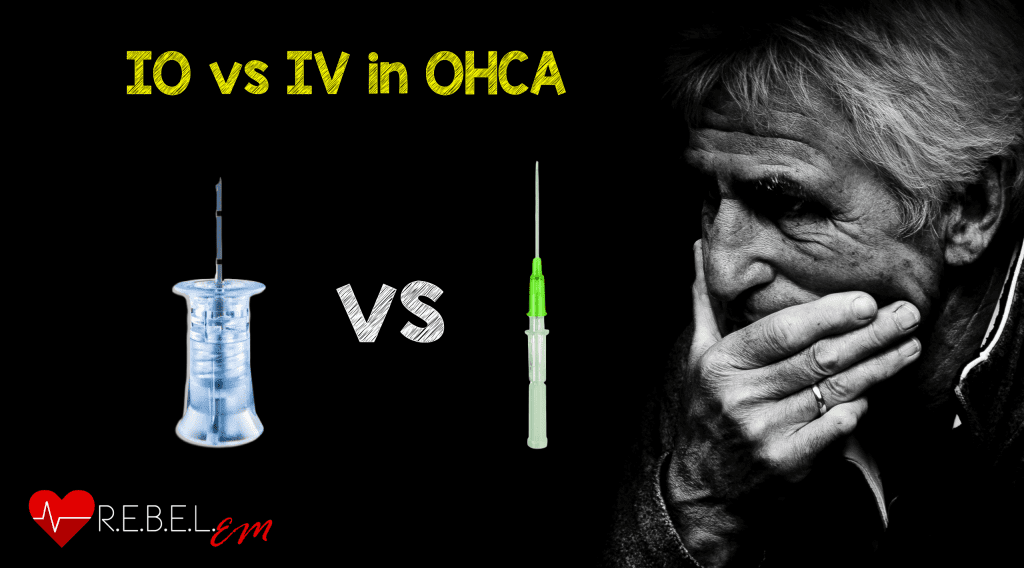
 Background: Placement of vascular access for administration of resuscitation drugs and fluids is a common procedure in the management of out of hospital cardiac arrest (OHCA). While intravenous (IV) placement has been the standard approach for decades, intraosseous (IO) access is rapid and safe and may be the preferred approach due to fact that the bone marrow does not collapse during shock states as peripheral veins often do. Despite it’s advantages, there are concerns about IO placement because of the potential for drugs to pool in the marrow and not circulate. Prior studies have shown an association with tibial IO placement and decreased rate of ROSC though no association with worse neurologic outcomes (Feinstein 2017).
Background: Placement of vascular access for administration of resuscitation drugs and fluids is a common procedure in the management of out of hospital cardiac arrest (OHCA). While intravenous (IV) placement has been the standard approach for decades, intraosseous (IO) access is rapid and safe and may be the preferred approach due to fact that the bone marrow does not collapse during shock states as peripheral veins often do. Despite it’s advantages, there are concerns about IO placement because of the potential for drugs to pool in the marrow and not circulate. Prior studies have shown an association with tibial IO placement and decreased rate of ROSC though no association with worse neurologic outcomes (Feinstein 2017).
Episode 44 – IV vs IO in OHCA
Click here for Direct Download of Podcast
Clinical Question: Is intraosseous access associated with lower rates of good neurologic outcomes after cardiac arrest in comparison to intravenous access?
Article: Kawano T et al. Intraosseous vascular access is associated with lower survival and neurologic recovery among patients with out-of-hospital cardiac arrest. Ann Emerg Med 2018. PMID: 29310869
- Population: Consecutively recruited, EMS treated patients > 18 years with non-traumatic cardiac arrest.
- Intervention: Intraosseous (IO) access
- Control: Intravenous (IV) access
- Outcome (Primary): Favorable neurologic outcome on hospital discharge (modified Rankin Scale score ≤3)
- Design: Secondary analysis of data collected in the Prehospital Resuscitation Using an Impedance Valve and Early Versus Delayed (PRIMED) study.
- Excluded: Patients who were incarcerated, pregnant, had do-not-resuscitate orders and those with arrests secondary to exsanguination or severe burns. Patients who had primary failed attempts at either intravenous or intraosseous, patients with both intravenous and intraosseous access and those with no access.
Primary Results:
-
13,155 patients with cardiac arrest included in analysis
- IO access n= 660 (5.0%)
- IV access n = 12,495 (95%)
- Patient demographics (see table 1 for full list)

Critical Findings:
-
Favorable Neurologic Outcome (primary outcome)
- IO: 1.5% (10/660)
- IV: 7.6% (945/12,495)
- Absolute difference = 6.1% (NNT = 16)
- Multivariate regression yielded an adjusted OR = 0.24 (95% CI 0.12 – 0.46)
-
Achievement of ROSC
- IO: 23.9% (158/660)
- IV: 38.3% (4,783/12,491)
Strengths:
- Asks a clinically relevant question
- Primary outcome is patient centered
- Multivariate regression performed to account for differences in patient groups
- Authors tried to account for differences in EMS protocols based on geographic location
Limitations:
- Study was not designed to specifically answer this question. This was a secondary analysis of data collected to answer a different research question
- No randomization of patients to different treatments introducing considerable selection bias (why did providers select IO vs IV access?)
- Significant baseline as well as in-hospital treatment differences between IO and IV patient groups with all important outcome predictors (shockable vs. nonshockable rhythm, bystander witnessed arrest, therapeutic hypothermia etc) favoring the IV group
- Attempted to exclude patients who had an alternate failed access attempt prior to successful access (i.e. IV attempted, failed and then IO placed). Difficult to capture all of these events and, impossible to capture the nuance of provider assessment and determination of difficult IV/IO placement
- Only 5% of patients who had access performed received an IO. May speak to low familiarity with procedure and reduce external validity
- There is no discussion of IO location (tibial vs humeral vs sternal) or IV locations (antecubital, hand etc). Different sites have different flow rates and, may produce different outcomes
- Quality of CPR delivered after the 1st 5 minutes is not described
Other issues:
- It is difficult to understand a physiologic explanation of these findings as there is no literature showing that administration of ANY resuscitative medication improves outcomes in OHCA
Authors Conclusions:
“In adult out-of-hospital cardiac arrest patients, intraosseous vascular access was associated with poorer neurologic outcomes than intravenous access.”
Our Conclusions: This study demonstrates an association only between IO access and worse neurologic outcomes. However, the study is rife with bias secondary to it’s design and thus, cannot be used to advise clinical practice. A well-done, randomized trial is needed.
Potential to Impact Current Practice: This study should not impact clinical practice. If vascular access is desired in an OHCA patient, the most rapid technique should be used and this will be dependent on the provider. Additionally, it should be stressed that obtaining access is not a critical step in OHCA management as no medication has been shown to improve meaningful outcomes (i.e. neurologically intact survival)
Bottom Line: This study should not influence providers to select one vascular access method over another in the resuscitation of OHCA. If vascular access is desired, use the most rapid approach.
References:
- Feinstein BA et al. Intraosseous compared to intravenous drug resuscitation in out-of-hospital cardiac arrest. Resuscitation 2017; 117: 91-96. PMID: 28629995
Post Peer Reviewed By: Salim R. Rezaie (Twitter: @srrezaie)
The post REBEL Cast Ep 44: IO vs IV in Out-of-Hospital Cardiac Arrest (OHCA) appeared first on REBEL EM - Emergency Medicine Blog.
